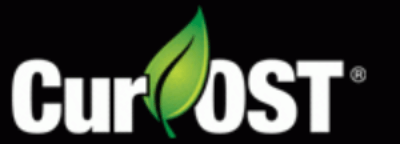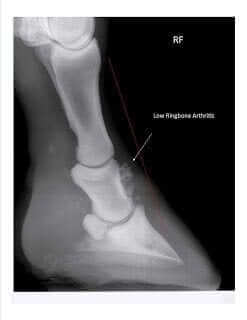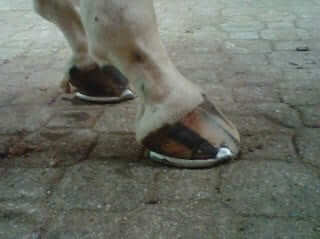Joint disease in the horse is the number one cause of ongoing lameness and a result of many factors including excessive or ongoing trauma, genetics, diet and lifestyle influences. Degeneration within the joint leads to cartilage erosion, remodeling of the joint, ongoing pain and reduced range of motion in more severe cases. It is a condition that is best prevented and managed in the early stages versus in the advanced stages. But, how exactly do you manage this problem of osteoarthritis and joint degeneration in your horse?
Therapies for joint disease in the horse now includes joint injections with corticosteroids, hyaluronic acid, poly-sulfated glycosaminoglycans (Adequan) and over the past several years, there is a new kid on the block termed IRAP or Interleukin-1 Receptor Antagonist Protein. IRAP therapy is supposed to help manage the inflammation and joint deterioration more effectively through the use of the body’s own natural resources.
Well, the truth is that this problem of joint degeneration in the horse is more complex than what you may believe. Despite these ‘newer’ therapies, the outcomes are usually not ideal or if they do result in improvement, it is short lived and the horse, and your wallet, become addicted to the treatments. In the end, more times than not, the horse is retired and living a life of discomfort.
As we have discussed in prior articles, inflammation is a complex subject and involves the ongoing release of several cytokines responsible for cellular changes and deterioration. Interleukin-1 is one of many cytokines, which act at many levels and are thought to be directly involved with cartilage loss. As a result of ongoing inflammation, IL-1 is released by various types of cells and binds to receptors at other cellular locations to inflict action. IRAP therapy works on the principle of blocking the receptor at which IL-1 binds within the joint, thereby reducing inflammation and pain. Blood is withdrawn from the horse, incubated in a special syringe that helps to stimulate the IL-1 receptor blocker and then injected into the joint. In most cases, it is recommended to complete a three injections series, one week apart. Cost can vary between clinics, but is reported to be between $1000 and $2500 for the complete series. Effectiveness is variable and at the time of this writing, I am unable to find published research dictating response rates, but it has been reported that if there is going to be a response, it will be seen by the second or third injection. Length of response rate is again variable, with most horses benefiting from results lasting 6-12 months, but then requiring either a booster injection or potentially a restart to the injection series. It has been noted that horses requiring further injections tend to show a reduced response rate.
Considerations in Joint Therapy in the Horse
IRAP therapy blocks the receptor in which IL-1 binds to within the joint, thereby in theory reducing inflammation, pain and further joint deterioration. As we have discussed in the past, inflammation involves several cytokines being produced and IL-1 is not the only one responsible for cartilage deterioration and pain production. For instance, there are other Interleukins that play a part in the cycle of inflammation and there are other cytokines such as MMP’s (matrix metaloproteinases) that are responsible directly for cartilage erosion. Even though we may be able to block the receptors at which IL-1 attaches within the joint, we are doing very little to impact the production of the other destructive cytokines. By using IRAP therapy, we are also doing little to impact the production of IL-1 overall and systemically, IL-1 levels will likely be on the rise even though they may be blocked from exerting their action within that specific joint. Overall, the effects of IRAP are localized and impact only a small portion of the inflammatory cycle.
The other consideration of course is cost and potential side effects from therapy. It is reported that side effects to the IRAP are very low due to using blood from the patient as part of the therapy, which is good, however, we are still sticking a needle into the joint on weekly intervals. With each repeated injection comes the risk of bacterial infection and the act of sticking a needle into the joint actually spurs on the process of inflammation.
Inflammation is Beyond the Joint in the Horse
Inflammation is an ongoing process and involves many cytokines, each with their own specific action. IRAP therapy is a new tool in the medicine chest for equine veterinarians, but from my perspective may have some major limitations. Considering the large number of cytokines being produced as a result of the inflammatory cascade, why not potentially target them at their source, instead of just trying to block their action? After all, inflammation is a systemic problem and in most instances, if there is one joint affected, there is another close by or potentially higher up in the leg or even the back that is taking extra pressure due to favoring or shifting of weight. We need to look at the problem from a systemic point of view, because that is where the problem lies.
Impacting Inflammation at It’s Source in the Horse
Is it possible to reduce the production of these cytokines at their source or at a cellular level? The answer is yes, but it is somewhat complicated. The process of inflammation involves the production of cytokines but also involves the release of free radicals with resultant oxidative stress, which actually can be a viscous circle of events, all playing a role in joint deterioration. Wouldn’t it possibly be better to reduce the production of IL-1 systemically, versus just blocking where it binds?
Curcumin, as a case example, has been shown in research trials to block the NF-kB transcription factor, which is directly responsible for the production of several cytokines, including IL-1. Curcumin has been shown to downregulate the production of many types of Interleukins, Prostaglandins, TNF and MMP’s. The effects are seen systemically instead of just locally, so the patient is benefiting overall from the health effects of mitigating the inflammatory response. Curcumin has also been shown to upregulate NRF2, which is directly responsible for production of naturally occurring antioxidants within the body, which help to reduce oxidative stress damage.
It sounds like Curcumin is the ‘end all be all’ of inflammation therapy, but it too has its limits. One of the limitations is dosing, which can vary dependent on the severity of the condition. There are many herbs that impact the process of inflammation and considering some limitations of curcumin, I have found it best to herbs together to get the best effect overall. Boswellia, for instance, counteracts inflammation at a different level than curcumin, which is mainly through lipoxygenase inhibition. When combined with curcumin, along with other anti-inflammatory herbs, the results can be incredible. This was demonstrated in our published paper in 2006 evaluating synovial cytokines pre and post curcumin administration in which 80% of horses responded with reduced synovial cytokine levels and a reduced lameness score.
Again, there are always going to be limitations. IRAP is generally listed for use in mild to moderate cases of osteoarthritis. Usage of herbal formulas, like our Cur-OST Pure or Cur-OST Inflammend formulas, are also best for early or mid stage cases, but can still have profound effects in later cases. Joint deterioration is not reversible and generally involves more than one joint. The progression of joint disease can be potentially mitigated by reducing cytokine production, but it is best when done at a systemic level.
In my experience, it may be a more sound decision to try to reduce systemic cytokine levels first before performing a more invasive and targeted therapy. The results may actually be seen sooner and affecting the patient systemically, not to mention at a much reduced cost.
Just my opinion.
Tom Schell, D.V.M.



